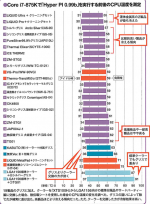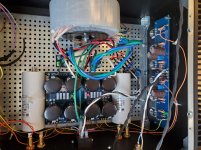This illustrates what the diodes are doing. The source at the left side is the AC from the transformer.
Full-Wave Rectifier w/ Filter

Having built a pair of F4's with the addition of a balanced XLR input that can easily be jumped to try both balanced and parallel drive into some Quad speakers (close to 4 ohm), I can say that I greatly prefer the sound of the parallel drive into the Quads. Fuller bass, larger soundstage, slightly sweeter or less dry top end. All of this attempted description of the two modes of operation is more subtle than changing the preamp driving them so others description of the variable or transparent nature of these amplifiers still holds true. Running the amplifier in a bridged mono configuration would cancel out some of the second harmonic distortion leaving a mostly 3rd hormonic signature which may explain some of the audible difference. At the quiet levels I typically run I doubt any current or voltage limitations are ever reached and the amps remain in class A operation.
I can say that I greatly prefer the sound of the parallel drive into the Quads. Fuller bass, larger soundstage, slightly sweeter or less dry top end. ...
Hello Stephen,
Do you use crossovers on yours speakers? Or drive each speaker driver individually with your 4 channels of F4? 2 ways stereo 🙂?
I am running the F4's as mono blocks so one for the left ch and one for the right. The quads are full range so there is no external crossover at the moment although I may add a sub in the future. In truth except for dance tracks or movie soundtracks I am not missing the sub as the F4 has such a firm grip on the speakers down to about 47 Hz.
In a balanced bridged configuration you feed signal into the left input and opposite polarity signal into the right input. This means you need a preamp or source with a balanced output. Connect the two hot speaker outputs (normally the L+ and R+) to the speaker with no connection to the cold speaker outputs. 2X the output voltage (almost) but with 2X the output impedance so best into 8 or even 16 ohm speakers.
Parallel operation feeds the same signal through a Y splitter or internal jumper into both L and R inputs. You then either bi-wire or jump the hot L speaker output to the hot R speaker output to make a combined hot feed to your speaker that has all of the devices in parallel so more current available at the same voltage. The cold speaker outputs should already be linked internally but it doesn't seem to hurt to jump them together as well. This configuration is better for lower impedance speakers.
As always experiment. Try both and discover which you prefer.
In a balanced bridged configuration you feed signal into the left input and opposite polarity signal into the right input. This means you need a preamp or source with a balanced output. Connect the two hot speaker outputs (normally the L+ and R+) to the speaker with no connection to the cold speaker outputs. 2X the output voltage (almost) but with 2X the output impedance so best into 8 or even 16 ohm speakers.
Parallel operation feeds the same signal through a Y splitter or internal jumper into both L and R inputs. You then either bi-wire or jump the hot L speaker output to the hot R speaker output to make a combined hot feed to your speaker that has all of the devices in parallel so more current available at the same voltage. The cold speaker outputs should already be linked internally but it doesn't seem to hurt to jump them together as well. This configuration is better for lower impedance speakers.
As always experiment. Try both and discover which you prefer.
Hi all, one channel of my f4 has started passing a very weak signal even when off for 5-10 minutes. The other channel does not. Any ideas on the cause? I don't necessarily care, but am concerned it may be a preview of a part or construction failure.
Thanks for your thoughts.
Thanks for your thoughts.
Last edited:
I'll also note that the two channels are mono blocks and are hence on their own power supplies.
Hi all, one channel of my f4 has started passing a very weak signal even when off for 5-10 minutes. The other channel does not. Any ideas on the cause? I don't necessarily care, but am concerned it may be a preview of a part or construction failure.
Thanks for your thoughts.
Do you mean music signal?
Do you mean music signal?
Yep, just a tiny bit of distorted output coming out of the drivers (I bi-amp, so out of both the tweeter and midrange that the F4 drives).
And sorry, should have stated that the preamp was pushing a music signal when this was happening in my first post...
That would seem like the caps aren’t draining when the power is cut to the amp.
Maybe recheck bias of the affected amp, it might be lower than it should be.
Maybe recheck bias of the affected amp, it might be lower than it should be.
if one put bleeders on cap bank , no way it's going to happen
though , I don't have bleeders in Papa's Koan , so I know for that fenomenon

though , I don't have bleeders in Papa's Koan , so I know for that fenomenon

If I wanted to wire my two F4 amps to be parallel mono blocks inside the chassis, could I just wire both speaker outs to the same output (one side) and do the same for the rcas (one side)?
Yep, do have bleeders to drain the caps. Can see the leds fade once the power is cut...
Then your preamp must be driving the speakers somehow.
Maybe signal is going through 0V, (just guessing here).
Is everything wired up with correct polarity?
Zenmod is probably gonna have a better idea about this one. I'm scratching my head.
there is some bleeding through of input signal ..... and it's normal
who cares why , exactly
Thanks Zen, as I noted above, I was just concerned that it wasn't happening in both channels, and thus was an indicator that a part might be failing. Otherwise, totally happy to ignore it.
Bad luck with a trivial part...
Hi friends, me again!
I received the greater part of everything for F4.
I had bad luck with one part so far.
Instead of the terminal block 5 posts, I ordered the part "cinch ms-5-140" which is just the ground plate. I searched a really long time in the mouser-jungle just to find the wrong one. BWAAH!
What part-number would be the correct one, then? please?
thank you!
david
Hi friends, me again!
I received the greater part of everything for F4.
I had bad luck with one part so far.
Instead of the terminal block 5 posts, I ordered the part "cinch ms-5-140" which is just the ground plate. I searched a really long time in the mouser-jungle just to find the wrong one. BWAAH!
What part-number would be the correct one, then? please?
thank you!
david
571-15463065 1546306-5 TE Connectivity Barrier Terminal Blocks .374 DOUBLE ROW 5P w/ binding screws
1546306-5 TE Connectivity / AMP | Mouser
1546306-5 TE Connectivity / AMP | Mouser
- Home
- Amplifiers
- Pass Labs
- A guide to building the Pass F4 amplifier


